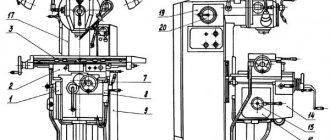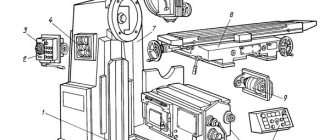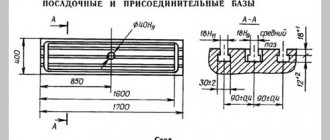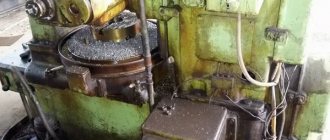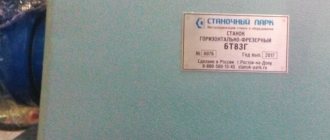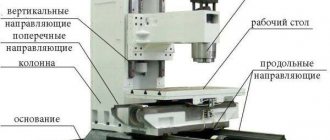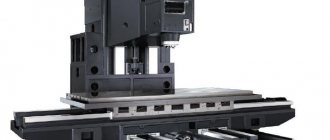Universal milling machines with a wide profile are very beneficial for a wide variety of large enterprises. The 6T13 unit is a vertical milling equipment that allows you to process straight, corner, and frame parts.
The machine can perform processing on a horizontal, vertical surface, as well as at an angle of 45°, and not only, more details about all the capabilities of the unit.
Purpose and scope
It is used in serial and individual production for milling parts from a wide variety of materials. The equipment processes:
- vertical and horizontal surfaces;
- grooves;
- corners;
- framework;
- gear wheels.
The unit has the ability to operate in three modes. The machine uses face, shaped, corner, cylindrical, and disk cutters. It is possible to obtain additional screw surfaces using a universal dividing head.
How does the rotating head of the machine work?
The image above shows the current drawing of the rotary head, which is used in the 6T12 machine. It is centered in the annular recess located in the neck of the frame, secured with 4 bolts that fit into 1 different groove of the frame flange.
The spindle consists of a double-bearing shaft, which is integrated into the sliding sleeve. Adjusting the axial play comes down to the need to grind rings 4 and 3. Elimination of increased play in the front bearing becomes possible by tightening the nut and grinding ring 5. The owner is required to follow the correct maintenance procedure. To get rid of the radial play, the value of which is one hundredth of a millimeter, a grinding of approximately 0.12 millimeters is required.
The spindle rotates through a pair of cylindrical and conical wheels that are installed in the head. The gears and bearings installed in the turning head are lubricated by a pump in the frame. Bearings responsible for the correct operation of the sleeve movement mechanism and spindle rotation - using the injection method.
Design features of a cantilever milling machine
The design features of the machine, in addition to high productivity, are aimed at ensuring the safety of the operator working with the equipment. The unit has a movable guard. Security is also ensured:
- duplicating the stop buttons of the unit;
- blocking system;
- mechanism for proportional reduction of feed during exit and entry.
There are other design features that make the job more efficient.
Dimensions and weight
The machine is a large piece of equipment. Its weight is 4200 kg. Unit dimensions:
- length – 256 cm;
- width – 226 cm;
- height – 212 cm.
The table surface has dimensions of 1600x400 mm.
List of components
The main components of the unit are the same as in most milling machines. But all components have some design features that allow them to perform the necessary functions:
- Cast frame. This is a wide rectangular platform, on pins with a vertical neck.
- Spindle head with sleeve. A rotary mechanism fixed in the annular recess of the frame, with a motor for clamping the cutting part.
- Control cabinet. It includes an electric spindle drive, as well as a gearbox, control panel and several important switches.
- Front console. The engine of the table guide elements, and devices for adjusting their movement.
Design features also include:
- Mechanized tool fastening. This increases the accuracy of part processing.
- The machine table is capable of rotating around a vertical axis by 45°. This way you can mill helical spirals.
- Automatic braking of the spindle head.
- Three operating modes: manual, automatic and jog.
- Limitation of the gap in the screw pair.
The additional rigidity of the machine makes it possible to process plates made of hard and super-hard synthetic materials.
Description and location of controls
One of the main controls is the gearbox, which contains 18 spindle speeds. For this purpose there is a special head with divisions. A handle for clamping the sleeve is installed separately.
The feed drive is controlled using normal and high speed clutches. There are also mechanical slide clamps, as well as consoles on the guide parts of the frame. All working elements have separate flywheels for manual control.
Kinematic diagram
Electric scheme
Features of the structure of the rotary head
The bed serves as the base for the rotating head of the unit. The head itself is equipped with a mechanism for manual and axial movement. This allows you to process surfaces that are located at an angle of 45°.
The rotating head is centered in a ring recess, to which it is attached with 4 bolts. The spindle head itself is a two-support shaft, which is mounted in a retractable sleeve. The frame pump lubricates the bearings and gears of the rotary head.
Electrical and kinematic diagram
Vertical machines equipped with electric drives of similar power allow the use of super-hard cutters and maximum cutting speed. The high coefficient of friction is compensated by lubricant supplied by a plunger oil pump to the drive elements and the main movement screws. The kinematic system is the transmission of impulse from the motor shaft through ball screws to the functional axes. The connections are equipped with replaceable elastic couplings.
Working with the unit is facilitated by an electromagnetic device for forced slowing down of the table movement and spindle rotation when turned off.
The stop occurs in 5 - 6 seconds. The brake clutch also protects the system from damage in case of overload. The standard electromechanical structure and universal equipment allow for expansion of capabilities through the modernization of individual components and the use of a large range of suitable spare parts for repairs.
Specifications
The 6T13 unit has the following technical characteristics:
- the maximum travel of the table along is 1 meter;
- transverse – 30 cm;
- vertical – 42 cm;
- from the end of the spindle head to the table, the distance is 30–500 mm;
- spindle speed up to 2000 rpm;
- the spindle quill moves 80 mm;
- one division of the dial is 0.05 mm.
The machine is equipped with four electric motors. The power of the main engine is 10 kW.
Location of components
The image presented above shows the layout of all the components of the 6t12 machine. In total, the presented vertical machine used consists of the following components and assemblies.
- Coolant pump starting system.
- Control system for the direction in which the spindle rotates - right or left.
- Electric motor to drive the table.
- A dial whose surface has a scale indicating the feed amount.
- Mushroom for switching feed.
- Handle for moving the table manually and vertically.
- Flywheel for moving the table manually and in the transverse direction.
- The handle that presses the slide to the console.
- A handle designed to control the longitudinal movement of the table.
- Electric motor for spindle drive.
- Duplicate handle, including longitudinal movement of the table.
- Flywheel for moving the table manually and in the transverse direction.
- Cams for turning off the longitudinal table feed system in automatic mode.
- Coolant supply valve.
- Start button panel mounted on the front of the skid.
- Duplicate handle for turning on vertical or transverse transmission.
- Switch for the workspace lighting system.
- Switch for the entire machine.
- Handle for selecting spindle speed.
- A dial whose scale indicates the number of revolutions.
- Gearbox indicator.
- Start button panel on the spindle box.
- Cams that automatically turn off the vertical table feed.
- Cams that automatically turn off the cross feed of the table.
- Handle, including vertical and transverse feed of the table.
Location of controls
The layout of all control bodies is shown in the image above. It is worth noting that the design of the equipment in question is characterized by a convenient arrangement of buttons and other controls. This facilitates a quick transition to performing the required operations. Even a specialist with minimal practical experience, thanks to the comfortable placement of control elements, will be able to intuitively understand the main list of functions.
Operation and repair, passport
The mechanism itself requires installation on a concrete foundation with a thickness of at least 30 cm. In this case, the surface must be perfectly flat. This will reduce the risk of inaccuracies during fine milling.
During initial start-up, be sure to fill the lubrication system reservoir with oil. Once a year you need to flush the oil reservoir. In case of any malfunction, the machine should be turned off and a technician should inspect it. Any part in the machine must be replaced when worn out, so the unit itself does not have a service life.
The passport of the milling machine can be downloaded for free from the link – Passport of the vertical console milling machine 6T13.
Modifications 6Т13Ф1 with DRO:
— vertical milling machine 6T13F1 with digital display. Normal performance. Has an accuracy class according to GOST - N, normal. Control panel on the console. Rotary milling head.
— vertical milling machine 6T13PF1 with digital display. Additionally, it has an increased accuracy class; the spindle is mounted on high-precision bearings and guides of a different class. The control panel is placed, for convenience, on a rotating bracket, along with the DRO.
Cantilever vertical milling machine 6T13F1 with digital display price – 2,050,000 rubles.
Accuracy class N. 1 year warranty.
Vertical milling machine 6T13PF1 with digital display price – 3,240,000 rubles.
Accuracy class P, cast iron frame - new, control panel and digital display on a bracket, 2 year warranty.
Safety precautions when working with the device
The machine is an object of increased danger. Therefore, when working with it, certain rules should be followed. Beginners must undergo safety training.
When working, the operator must wear special clothing. It is prohibited to approach the machine while intoxicated. Before work, you should check the grounding. It is also prohibited to switch speeds and modes while the head is rotating. The control cabinet door and access to the electric drives are locked with a key.
Machine lubrication system
Machine lubrication is provided by the following systems.
1. Centralized lubrication system for gears, gearbox bearings, BEARINGS and gears of the rotary head and gearbox elements.
This system includes a reservoir 2 located in the frame, a filter 4, a plunger pump 6 and an oil distributor 7. The system pump is powered by an eccentric mounted on one of the gearbox shafts (Fig. 24).
Monitoring of the lubricant supply and its level in the reservoir is carried out visually using oil indicators 1 and 9.
2. Centralized lubrication system for gears, console bearings, console guides, slides and table.
This system includes a reservoir 24 located in the console, a safety valve 26, a gear pump 25, a spool 15, and oil distributors 11,12,14. The design of the spool valve is shown in Fig.
The presence of oil in the reservoir is checked using oil indicator 20, pump operation is monitored using oil indicator 19.
The console guides are lubricated periodically by pressing button 16, and the table guides by pressing button 17.
Quick-acting dry clutches for selecting the direction of table movement are located in the console compartment, protected from oil by oil seals and seals. Oil getting into this compartment leads to a loss of transmitted torque and coupling speed, as well as an unacceptable loss of table positioning accuracy.
Reviews
For the most part, large enterprises are happy to purchase 6t13 equipment. This machine can easily process large parts weighing up to 630 kg. At the same time, the equipment is equipped with additional safety elements and a rotary table, which allows you to process the workpiece at an angle. Users also note the long service life of this equipment.
The 6T13 cantilever milling machine began production in 1985 and has since been successfully used in mass production. The rigidity of the design allows you to process the hardest materials and use high-speed steel cutters.
General information
In the mid-80s, Gorky mastered the production of new brands of milling machines: 6T12, 6T13, representing the development of the R generation. The purpose and scope of application remained the same: milling of all kinds of parts mainly from ferrous metals and alloys in workshops with the type of production from single to medium-series.
Explanation of the name of the machine according to ENIMS encoding:
- 6- milling (group);
- T- modification (series);
- 1- vertical (subgroup);
- 3- standard size (version);
- normal accuracy (class H is not indicated in the designation).

